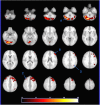Story time turbocharger? Child engagement during shared reading and cerebellar activation and connectivity in preschool-age children listening to stories
- PMID: 28562619
- PMCID: PMC5451016
- DOI: 10.1371/journal.pone.0177398
Story time turbocharger? Child engagement during shared reading and cerebellar activation and connectivity in preschool-age children listening to stories
Abstract
Expanding behavioral and neurobiological evidence affirms benefits of shared (especially parent-child) reading on cognitive development during early childhood. However, the majority of this evidence involves factors under caregiver control, the influence of those intrinsic to the child, such as interest or engagement in reading, largely indirect or unclear. The cerebellum is increasingly recognized as playing a "smoothing" role in higher-level cognitive processing and learning, via feedback loops with language, limbic and association cortices. We utilized functional MRI to explore the relationship between child engagement during a mother-child reading observation and neural activation and connectivity during a story listening task, in a sample of 4-year old girls. Children exhibiting greater interest and engagement in the narrative showed increased activation in right-sided cerebellar association areas during the task, and greater functional connectivity between this activation cluster and language and executive function areas. Our findings suggest a potential cerebellar "boost" mechanism responsive to child engagement level that may contribute to emergent literacy development during early childhood, and synergy between caregiver and child factors during story sharing.
Conflict of interest statement
Figures





References
-
- Cree A. The Economic and Social Cost of Illiteracy: A Snapshot of Illiteracy in a Global Context. World Literacy Foundation; 2012 April 2012.
-
- Heath SM, Bishop DV, Bloor KE, Boyle GL, Fletcher J, Hogben JH, et al. A spotlight on Preschool: the influence of family factors on children's early literacy skills. PLoS One. 2014;9(4):e95255 doi: 10.1371/journal.pone.0095255 - DOI - PMC - PubMed
-
- National Literacy Trust. Literacy: state of the Nation. UK: National Literacy Trust; 2011.
-
- National Center for Education Statistics. National Assessment of Educational Progress at Grades 4 and 8: Mathematics and Reading. In: Sciences. IfE, editor. Washington, DC: National Center for Education Statistics; 2015.
MeSH terms
LinkOut - more resources
Full Text Sources
Other Literature Sources

